Prairies, also known as grasslands, are vast expanses of flat lands covered with grasses and scattered with trees and bushes. These open spaces are home to a diverse array of wildlife, including birds.
Birds are an essential part of the prairie ecosystem, contributing to its balance and biodiversity. The prairie is a critical habitat for many species of birds, including grassland and aerial hunters, seed eaters, and migratory birds traveling from Alaska to South America.
The bird populations in the prairie have faced various challenges, such as habitat destruction and changes in climate. Therefore, understanding the role of birds in prairie ecosystems and their conservation is critical to ensure the long-term survival of these magnificent creatures.
1. Loggerhead Shrike
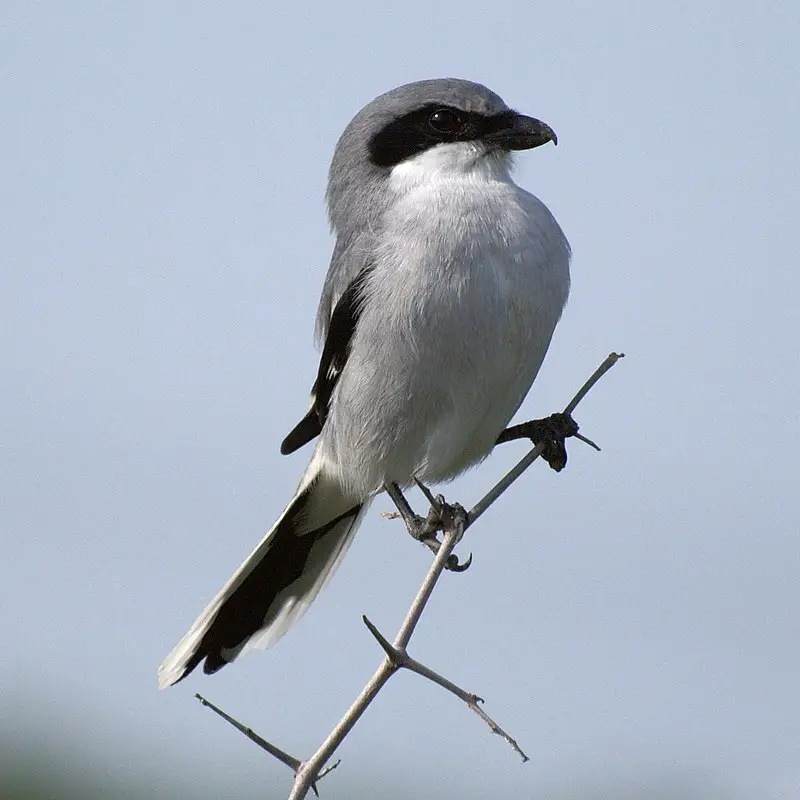
The Loggerhead Shrike is a carnivorous bird found only in North America. It belongs to the family Laniidae and is known as the “butcherbird” because of its habit of catching prey, such as amphibians, insects, lizards and small mammals.
The shrike has a black mask around its eyes and grey wings with white patches on them.
Its back is black with white spots that resemble stars or snowflakes; some individuals may have brown feathers instead of black ones.
This species feeds mainly by perching from elevated locations like bushes or trees where it can spot potential meals below it before diving down for capture.
Interestingly enough, these birds are also known to store their food by impaling it onto thorns which they use later when hungry.
With less than 2 million estimated population left in wild today this species needs our help so we should do whatever we can to protect them better.Scientific classification:
| Kingdom | Animalia |
| Phylum | Chordata |
| Class | Aves |
| Order | Passeriformes |
| Family | Laniidae |
| Genus | Lanius |
| Species | L. ludovicianus |
Also Featured In: Top Birds Found in Mexico, Birds Live in Arkansas
2. Prairie Falcon
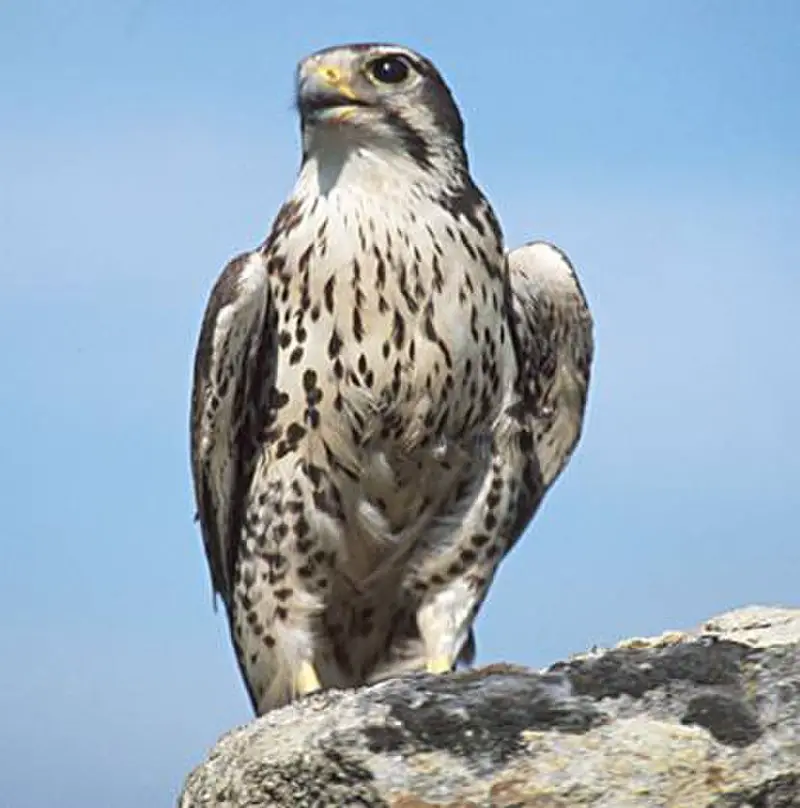
The Prairie Falcon is a distinct species of medium-large sized falcon found in western North America. It has an average length of 40cm, wingspan of 1 meter and weighs around 720g.
Females tend to be larger than males typical for all falcons.
Although separate from the Peregrine Falcon, they share many similarities such as similar coloring on their back and shoulders with dark spots on light brown feathers which helps them blend into the environment while hunting prey like small birds or rodents over open areas like grasslands or deserts.
They are also known to fly extremely fast reaching speeds up to 80 miles per hour.Scientific classification:
| Kingdom | Animalia |
| Phylum | Chordata |
| Class | Aves |
| Order | Falconiformes |
| Family | Falconidae |
| Genus | Falco |
| Species | F. mexicanus |
Also Featured In: Falcons Species, Birds that Live in the Deserts
3. Dickcissel
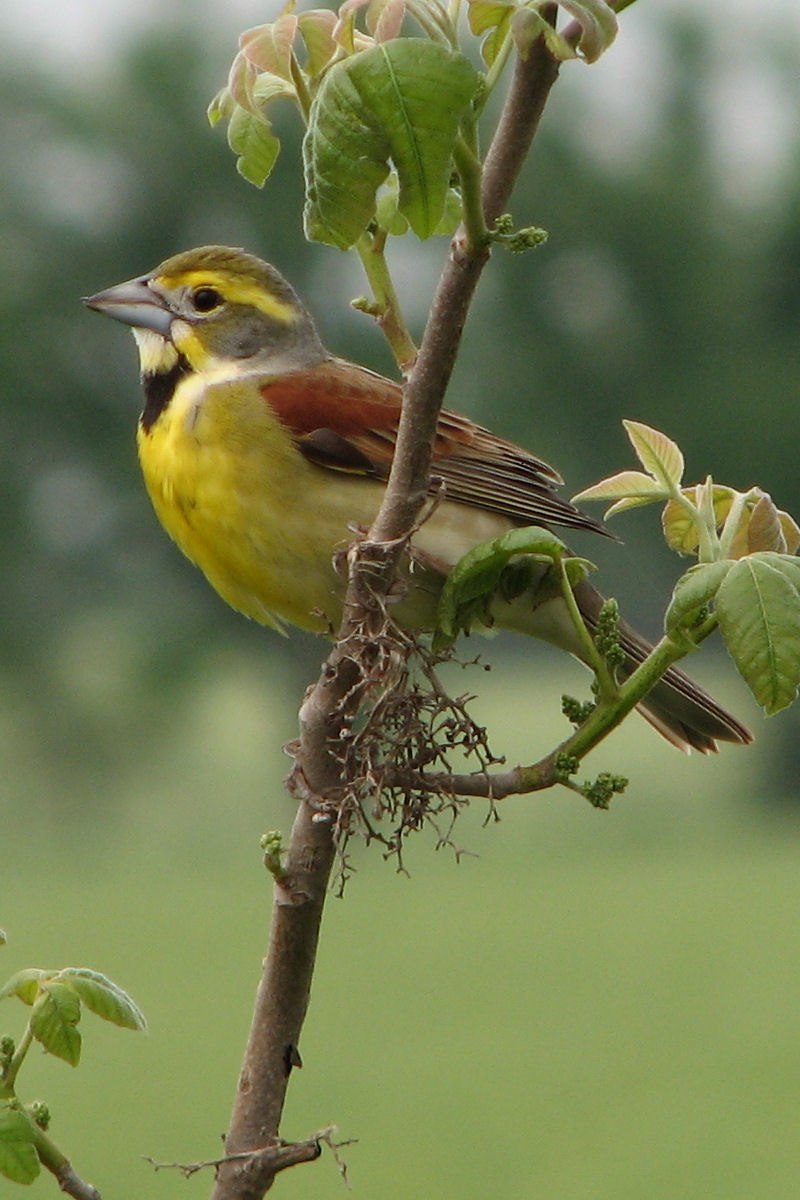
The Dickcissel is a small migratory bird belonging to the Cardinalidae family. It breeds in grasslands of the Midwestern US, and winters in Central America, northern Colombia and Venezuela.
Being the only member of its genus Spiza, it stands out from other birds with its distinctive song that sounds like “dick-sis-sel”.
With a light brown body and black streaks on its wings as well as chestnut colored shoulders and crowns, these birds are quite attractive to watch.
They also have short bills which they use while foraging through tall prairie vegetation or searching around fence posts for insects.
Although not endangered yet, their population has declined due to loss of habitat caused by human development so conservation efforts should be taken up soon.Scientific classification:
| Kingdom | Animalia |
| Phylum | Chordata |
| Class | Aves |
| Order | Passeriformes |
| Family | Cardinalidae |
| Genus | Spiza Bonaparte, 1824 |
| Species | S. americana |
Also Featured In: Sparrows Species, Birds that Live in the Grasslands
4. Chestnut-Collared Longspur
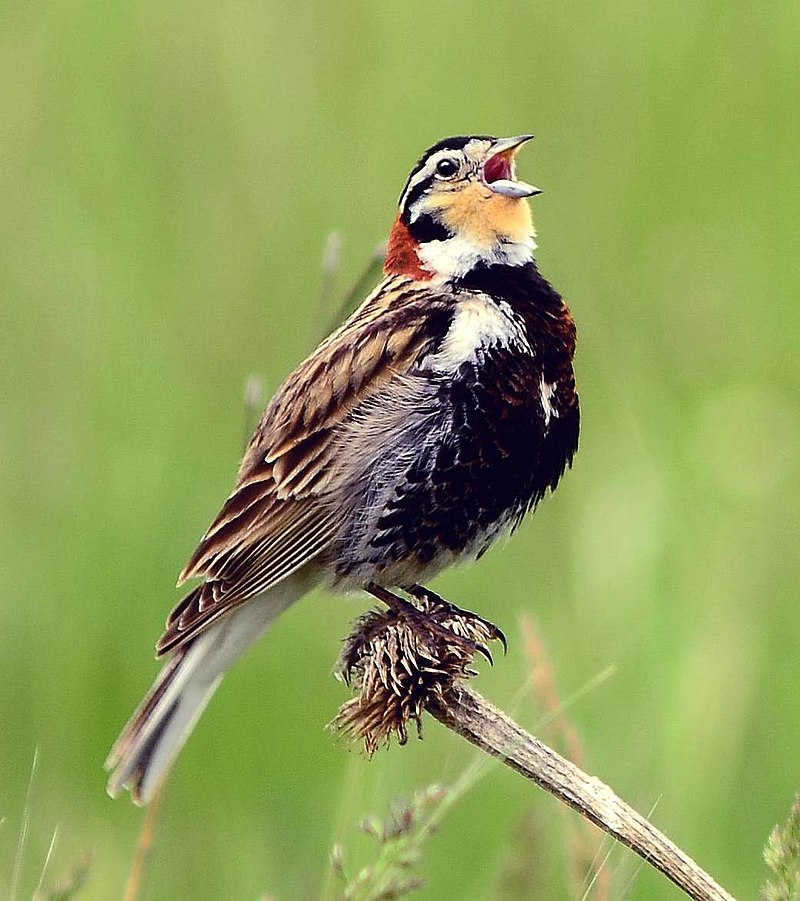
The Chestnut-collared Longspur is a small, seed-eating bird that primarily inhabits prairie habitats in Canada and the northern United States.
It has a short conical bill, a streaked back and white tail with dark markings along its edges.
During the breeding season they move northward to their nesting grounds while during winter they migrate southwards towards Mexico and parts of US where temperatures are more favourable for survival.
They form flocks when migrating or searching for food which can contain up to 50 birds at any given time.
The diet of this species consists mainly of seeds but also includes insects such as grasshoppers, beetles etc., making them an important part of the local ecosystem by controlling insect populations.
These little birds may be hard to spot due to their elusive nature but if you’re lucky enough you might spot one on your next visit outdoors.Scientific classification:
| Kingdom | Animalia |
| Phylum | Chordata |
| Class | Aves |
| Order | Passeriformes |
| Family | Calcariidae |
| Genus | Calcarius |
| Species | C. ornatus |
5. Greater Prairie Chicken
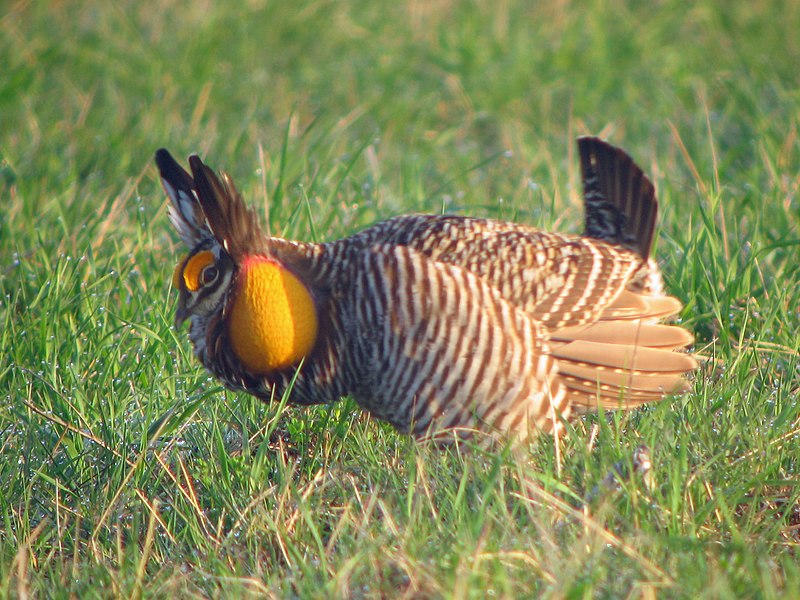
The Greater Prairie Chicken is a unique bird belonging to the grouse family. It was once extremely abundant across North America, with flocks seen in prairies and grasslands.
Sadly, because of habitat loss its population has drastically declined over time and it’s now considered endangered or extirpated in many areas.
To help ensure sustainability for these remaining populations, conservation efforts are being made.
The most remarkable feature of this species is their mating ritual called “booming”.
During breeding season males gather together on traditional booming grounds where they dance vigorously while producing loud sounds through inflatable air sacs located on either side of their necks – quite an impressive display.
Let us all work together to protect our natural world so that we can continue to enjoy these special creatures’ beauty and grace for generations to come.Scientific classification:
| Kingdom | Animalia |
| Phylum | Chordata |
| Class | Aves |
| Order | Galliformes |
| Family | Phasianidae |
| Genus | Tympanuchus |
| Species | T. cupido |
Also Featured In: Nebraska Birds,
6. Lesser Prairie Chicken
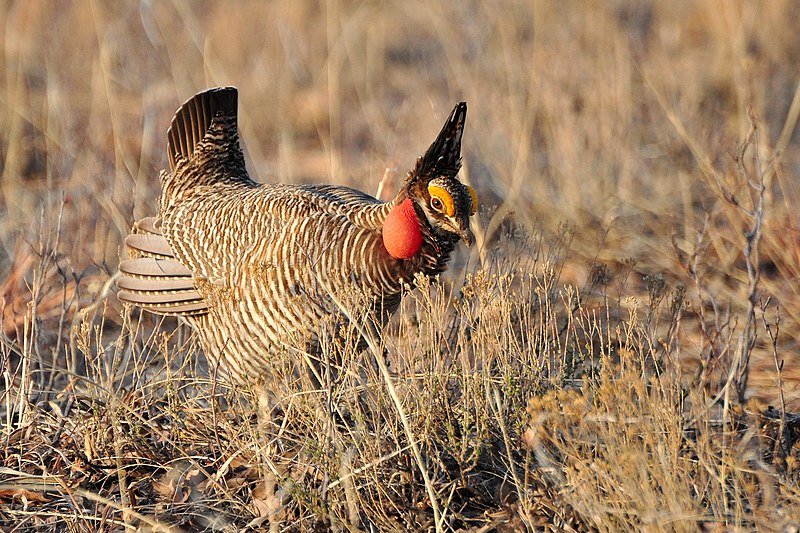
The Lesser Prairie Chicken is a species of grouse found in the North American Midwest. It is smaller and paler than its relative, the Greater Prairie Chicken.
Adults measure between 15 to 16 inches long and weigh about 22-29 ounces on average. They are distinguished by their white and brown stripes.
Currently, around half of the population lives in western Kansas with some scattered populations across Colorado, Oklahoma, New Mexico and Texas.
This bird’s numbers have been declining due to loss of habitat caused by farming practices as well as energy development activities that take away from its grassland home environment which it needs for food sources such as insects or seeds that can be found there.
Conservation efforts must continue if we want to keep this beautiful native species alive.Scientific classification:
| Kingdom | Animalia |
| Phylum | Chordata |
| Class | Aves |
| Order | Galliformes |
| Family | Phasianidae |
| Genus | Tympanuchus |
| Species | T. pallidicinctus |
Also Featured In: birds of New Mexico,
7. Prairie Warbler
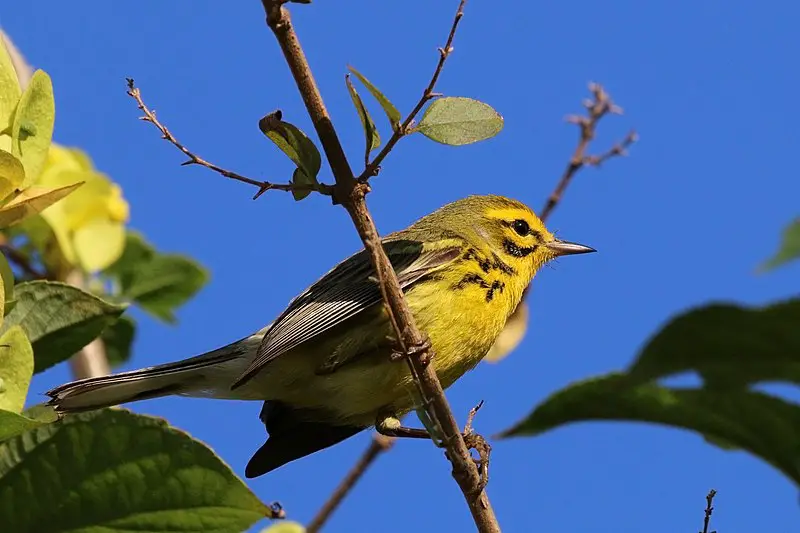
The Prairie Warbler is a small, colorful songbird of the New World warbler family. It has yellow underparts with dark streaks on its flanks and olive overparts with rusty streaks on its back.
Its head features a bright yellow line above the eye, contrasted by a darker line through it and finished off with an additional bright yellow spot below.
Black legs, long tails, two pale wing bars and thin pointed bills complete this bird’s look.
In flight they are known to have erratic movements while singing their distinctive loud “tseet” call as they pass overhead in migration or migrate between summer breeding grounds and wintering areas further south each year.Scientific classification:
| Kingdom | Animalia |
| Phylum | Chordata |
| Class | Aves |
| Order | Passeriformes |
| Family | Parulidae |
| Genus | Setophaga |
| Species | S. discolor |
Also Featured In: birds of Kentucky, Most Common Songs Birds that Live around You
8. Sharp-Tailed Grouse
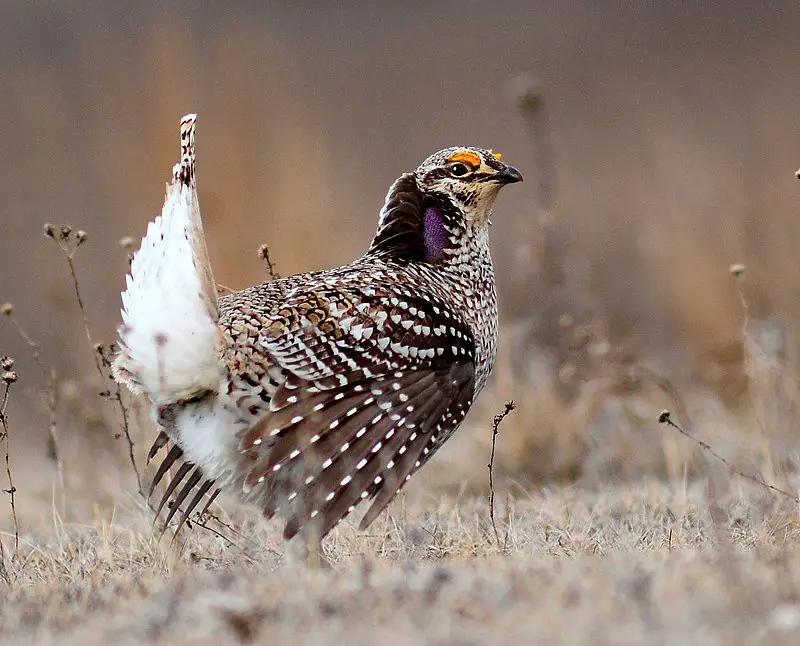
The Sharp-tailed Grouse is a medium-sized prairie grouse found in Alaska, Canada and parts of the U.S. It is known for its sharp tail feathers which are used to communicate with other birds during courtship displays.
The male typically has greyish brown plumage, yellow or reddish eyes and black barring on its neck and wings while the female tends to have more muted colours but still possesses a distinct “sharp” tail feather pattern.
This bird eats mostly grasses, seeds and insects as well as some fruits when available.
It nests on the ground usually near trees or shrubs where it will remain until breeding season begins in late spring/early summer months where males perform their elaborate mating dances with many females at once.
The Sharp-tailed Grouse is an iconic species of North America being named provincial bird of Saskatchewan province in Canada highlighting its importance within this region’s ecosystems.Scientific classification:
| Kingdom | Animalia |
| Phylum | Chordata |
| Class | Aves |
| Order | Galliformes |
| Family | Phasianidae |
| Genus | Tympanuchus |
| Species | T. phasianellus |
Also Featured In: birds of North Dakota, Common Birds in Saskatchewan
9. Sprague’s Pipit
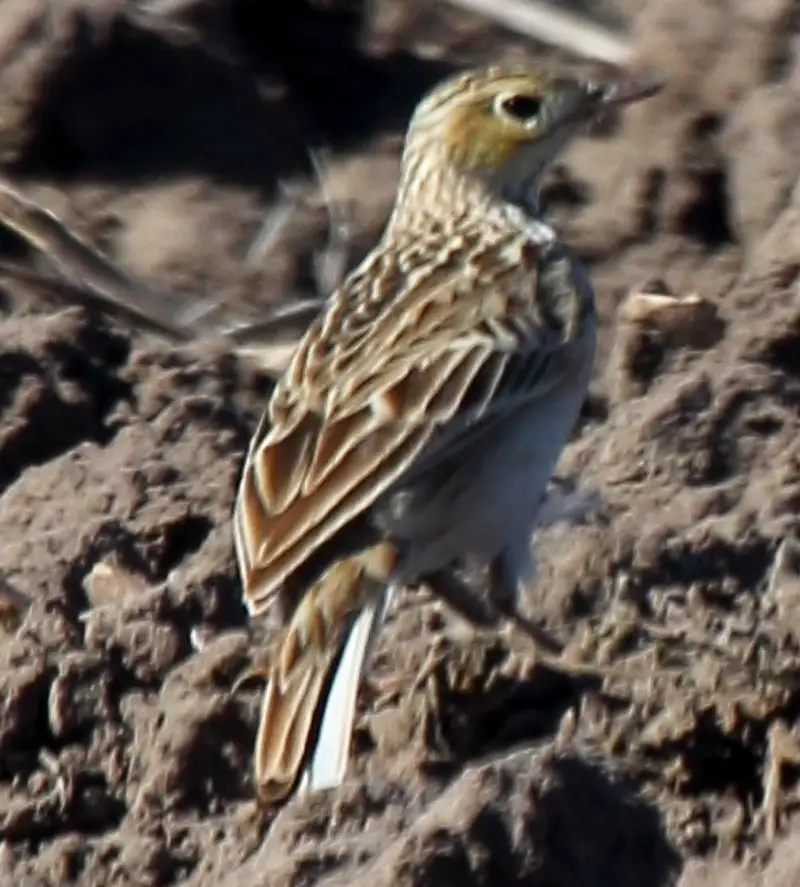
Sprague’s pipit is a small songbird found in the short- and mixed-grass prairies of North America.
It migrates to the southwestern United States and northern Mexico for winter, displaying an unusual behavior: it sings high up in the sky like a goldfinch or skylark.
The brownish bird has white streaks on its back, black markings on its head, yellow legs, and a thin bill. Its diet consists mainly of insects but also includes seeds from grasses.
During breeding season they make long flights while singing their loud songs which can be heard even over large distances.
Sprague’s Pipits are unfortunately becoming rarer due to habitat loss caused by human activities such as conversion of native prairie into cropland or pastureland.Scientific classification:
| Kingdom | Animalia |
| Phylum | Chordata |
| Class | Aves |
| Order | Passeriformes |
| Family | Motacillidae |
| Genus | Anthus |
| Species | A. spragueii |
10. McCown’s Longspur
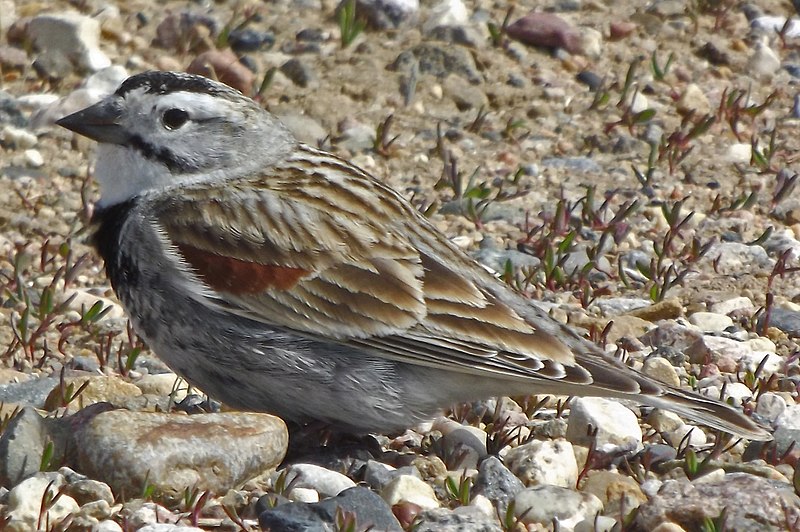
McCown’s Longspur, now known as the Thick-billed Longspur, is a small bird that feeds on the ground. It is part of the Calcariidae family, which includes other longspurs and snow buntings.
The bird is found in North America and is the only species in the Rhynchophanes genus. The American amateur ornithologist George Newbold Lawrence first described the species in 1851.Scientific classification:
| Kingdom | Animalia |
| Phylum | Chordata |
| Class | Aves |
| Order | Passeriformes |
| Family | Calcariidae |
| Genus | Rhynchophanes Baird, 1858 |
| Species | R. mccownii |
11. Prairie-Chickens
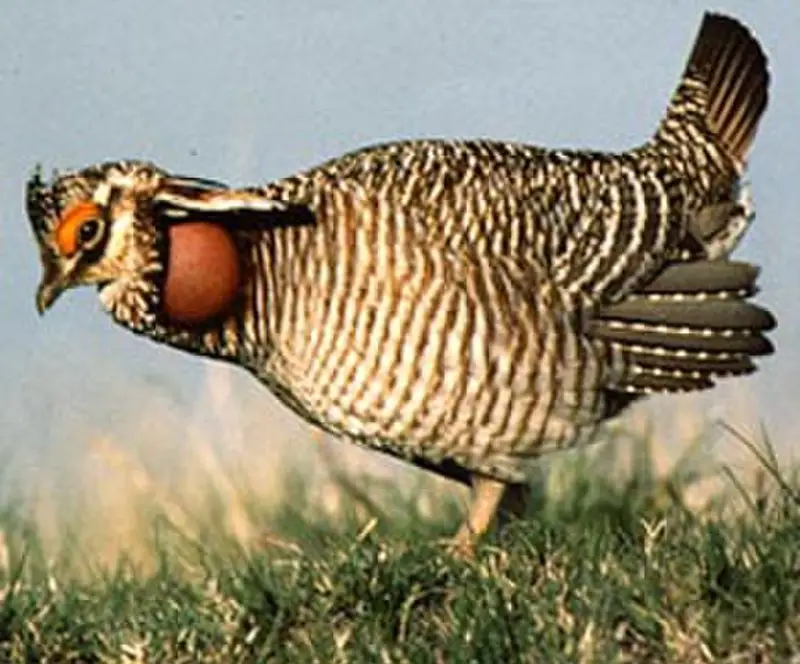
Prairie-chickens are birds from the Tympanuchus genus in the grouse family. They are also known as sage grouse. This genus was introduced by a German zoologist in 1841.
The name Tympanuchus combines the Greek words for “kettle-drum” and “to sound”. Prairie chickens are made up of three species.
These birds are known for their unique courtship displays where males gather in groups to perform elaborate dances and calls to attract females.
Prairie-chickens can be found in grasslands and shrublands throughout North America, where they feed on seeds and insects.
However, their populations have declined due to habitat loss and hunting. Conservation efforts are underway to protect these fascinating birds.Scientific classification:
| Kingdom | Animalia |
| Phylum | Chordata |
| Class | Aves |
| Order | Galliformes |
| Family | Phasianidae |
| Tribe | Tetraonini |
| Genus | Tympanuchus Gloger, 1841 |
12. Heath Hen
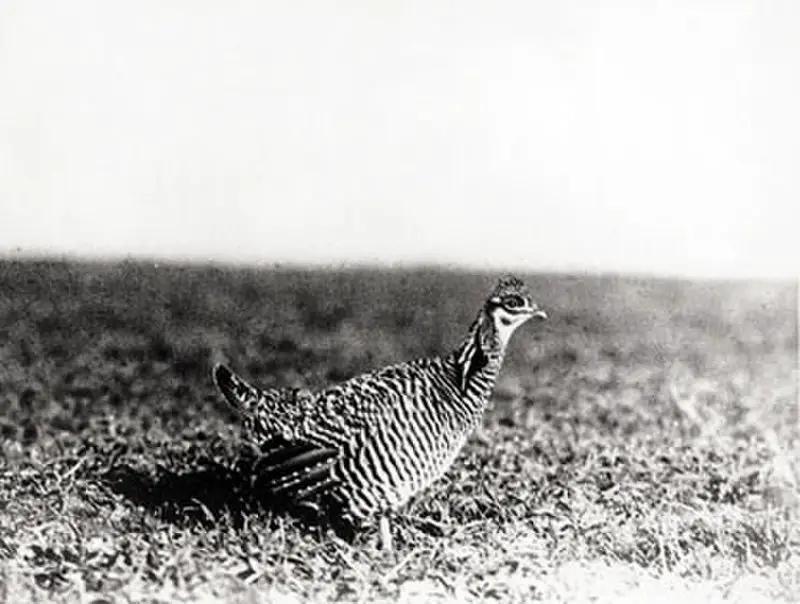
The Heath hen bird was once a subspecies of the greater prairie chicken. Sadly, it went extinct in 1932. These birds lived in heathland barrens along the coastal regions of North America, from New Hampshire to Virginia.
Unlike other subspecies of prairie chickens, the Heath hen was unique in its appearance and manner of living. With the loss of their natural habitat due to hunting and environmental change, the birds slowly disappeared.
Today, the Heath hen is remembered as an important component of North America’s thriving ecosystem, and scientific research continues to honor its legacy.
Despite its extinction, there is hope that future generations can learn from this tragic story of loss and work towards the preservation of other wildlife species.Scientific classification:
| Kingdom | Animalia |
| Phylum | Chordata |
| Class | Aves |
| Order | Galliformes |
| Family | Phasianidae |
| Genus | Tympanuchus |
| Species | T. cupido |
| Subspecies | †T. c. cupido |